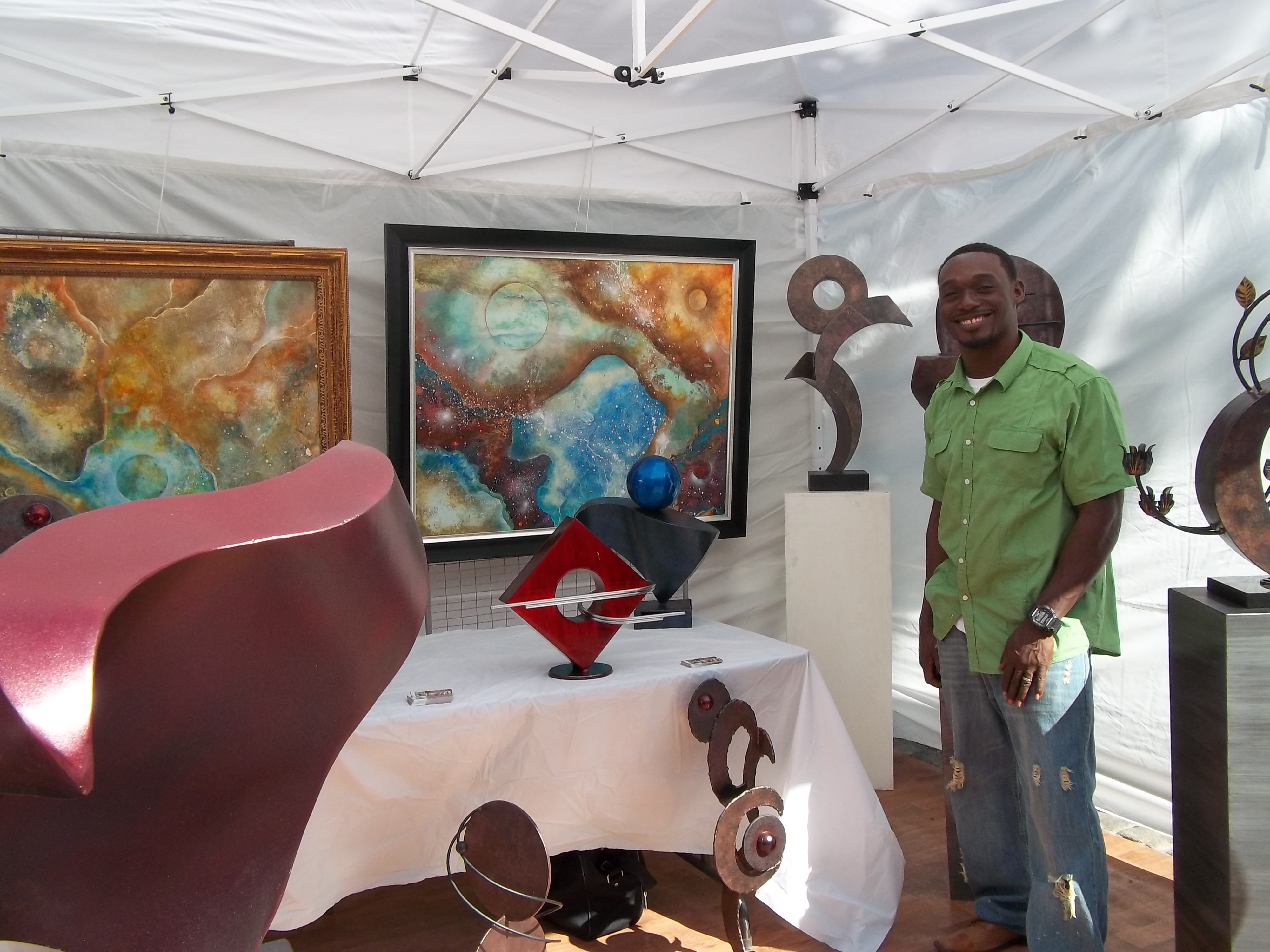Booth envisioned the Cranbrook Academy of Art as the community's educational centerpiece, a place that would actively influence the creative aspirations of Cranbrook while assuming a major role within the nation's artistic life. In the late 1920s, Booth took tentative steps toward realizing this dream by opening craft workshops, joining masters and students, to aid in the embellishment of the Cranbrook institutions and to promote artistic handwork to the general public. When the earthquake struck on April 18, 1906, Frederick Meyer lost his home and studio, Craftsman's Shop, to the ensuing fires that swept through the city, destroying everything the trembling did not. Meyer, not knowing what those words would inspire, returned to Europe to see new Scandinavian designs and to buy studio materials for Arthur and Lucia Mathews, with whom he had begun working after the earthquake. Hence, though burdened by the demands of running his many businesses, Booth labored tirelessly in the first decades of the twentieth century to advance the Arts and Crafts movement in the United States. Gathering support from Detroit's architectural and artistic communities, he helped to organize the Detroit Society of Arts and Crafts in 1906 and served as its principal patron for several decades.
With his backing, the society became one of the most active craft organizations in the country, serving up exhibitions, lectures, public theatrical performances, sales of crafted objects, studios for artistic production, and eventually a school. By the turn of the twentieth century, mass-produced furniture was available in most southern communities through mail-order catalogs and traveling salesmen. However, many people in the South were poor, particularly in the Appalachians and remote areas such as the Sea Islands, and so they were not consumers of mass-produced furniture, relying instead on the woodworking skills of those in their community. By the middle of the twentieth century, just a few traditional furniture makers were working. By studying and writing about community—and culture-based traditions—folklorists and scholars fostered early interest in southern handcrafted furniture.
At the same time, the artists themselves joined together in the Southern Highland Craft Guild to promote the sale of their handmade goods. Berea College, Kentucky, has one of the longest-operating weaving programs. Looms were built for local women to reproduce kiverlets based on weaving drafts that had been passed down for several generations.
Later, other crafts were added to the curriculum at Berea, where students are required to learn practical skills as part of their formal education. Today, visitors can still purchase finely woven products there, along with handmade brooms and other small pieces of furniture. Jugtown Pottery is one of the oldest shops, established in 1921 by Jacques and Juliana Busbee to produce high-quality, handmade pottery similar to the wares made in North Carolina in the late-nineteenth century.
Among the original ten to fifteen people who operated the pottery were Henry Chrisco, Rufus Owen, James H. Owen, and J. The Busbees also hired Ben Owen and Charlie Teague as teenagers, then cultivated their artistic talents by sending them to visit museums throughout the United States. Influenced by Chinese and Japanese ceramics, the potters at Jugtown developed new forms such as the Persian Jar—a wide-mouthed jar that tapers to the shoulder and then flares again, with a rope decoration at the shoulder. They also used glazes such as Chinese Blue and Mirror Black that were patterned after the Asian ceramics.
However, they respected the traditional forms of bean pots and teapots and continued to produce them. Ben Owen became the main potter at Jugtown, working there until 1952, when he opened his own shop. His grandson, Ben Owen III, has become a master potter, too, and continues the family tradition to this day. Many of these traditional crafts declined in use after the Civil War, with the change from an agrarian economy to an industrial one and the increased availability of mass-produced goods. For the first time, forces outside of the families and small communities—most of them religious missionaries or educators—began to have an important influence on the preservation not only of existing artifacts but also of the skills needed to make them. After World War II, interest in handmade arts and crafts declined again, but by the late 1960s, it was on the rise and it has been sustained ever since.
Many contemporary studio-furniture makers have chosen the ordinary chair as the ideal form in which to explore their ideas. As this gallery of traditional and unconventional chairs shows, the "new" studio craftsman has answered the call to create diverse and intriguing pieces. These provocative chairs test the relationship of form and function and exploit the intricate connections between art, architecture, craft, and design. Most students look upon their Cranbrook years as the defining periods of their lives, and, true to form, most have continued to grow by delving into new media after they leave. Charles Rossbach, for instance, who concentrated in ceramics and weaving at the academy, went on to establish himself as a top textile designer before experimenting with nontraditional material such as foil, twine, plastics, and twigs in his pieces. His Ceremonial Vessel with Shells, a late work from 1991, refers also to his fascination with basketry, the subject of two of his books.
Convinced that "pots" could convey ideas as powerful as any work of art, DeVore turned out enigmatic pieces with undulating surfaces, folds, lacerations, and recesses that challenged viewers to ponder the artist's intent and the meaning of the work. His ideas paved the way for later generations of Academy craft artists, who never questioned that they aimed for expression and not necessarily functionalism in their work. Myra Mimlitsch-Gray's Candelabrum, Seven Fragments, for example, a whimsical depiction of a melted candelabrum, actually calls into question more serious issues of materiality, impermanence, and artistic objective. Such a technically demanding piece would never have been created in the Saarinen era, for it boldly functions in the conceptual realms of aesthetics and theory, without concern for utility. In their antipathy toward the factory, the proponents of the Arts and Crafts movement saw the arts and crafts as instruments for social change. The movement was based on the belief that a return to handmade objects and to "the simple life"—an emulation of the lifestyle of the craftsman—would provide an antidote to the ills inflicted on society by modern life.
The movement took root both philosophically and aesthetically in England, spread through continental Europe, and crossed the Atlantic in the early 1890s. In America the movement permeated the visual arts and architecture and effected sweeping changes in domestic life. Its philosophy, ideals, and doctrines have left a stylistic imprint on the design and making of crafts and provided the standards against which the quality and worth of handcrafted objects are judged today. I'm an artist and art teacher living in Germantown and they always have what I need for my own personal use and for my students and my classroom.
I also love the convenience of a local art supply store and not having to drive into Center City for quality art supplies. Artist & Craftsman Supply, an employee owned company, has been providing artists with excellent materials at competitive prices since first opening in Yarmouth, Maine in 1985. Our stores carry a wide variety of supplies for all types of arts and crafts that are on average 15-20% off of the manufacturer's suggested list price. Any questions can be answered by our helpful, knowledgeable staff of artists.
Im an artist and art teacher living in Germantown and they always have what I need for my own personal use and for my students and my classroom. In many respects, the new studio crafts movement was born in 1957 at the Asilomar Conference Grounds in Pacific Grove, California. This seminal conference sponsored by the American Craft Council brought together studio craftsmen who had never met and in many cases were unaware of one another's works. Here, for example, California's Sam Maloof met Pennsylvania's Wharton Esherick, who led discussions with other wood craftsmen. The 450 attendees constituted a who's who of craft artists, educators, and designers, from both the old and the new traditions. Beyond its vital exchanges and bonding experiences, the conference was an affirmation of the significance of craft.
Many of the émigrés who came to America were distinguished and experienced professionals—artists, scholars, theorists, doctors, scientists—some of the greatest minds of their time. That Rice was able to bring many of them to Black Mountain greatly enhanced and enriched the college's curricula, as well as its reputation. Moreover, Rice added to the faculty of émigré artists acclaimed linguists, poets, mathematicians, performers, and historians, all chosen for their progressive ideologies and willingness to become wholly invested in the educational experiment. This faculty mix of European and American master artists and scholars created a dynamic, receptive environment, setting the stage for cross-pollination of ideas and a vanguard assault on conventional academia. Earthenware and stoneware forms dominate traditional southern pottery.
The earliest examples are earthenware vessels produced by Native Americans using the coiling method to make utilitarian and ceremonial pots, pipes, and figures. These pieces were fired in a pit and then burnished to a high gloss, a tradition the Catawba and Cherokee Indians have continued into the twenty-first century. The Qualla Arts and Crafts Mutual was established in 1949 on the Cherokee Indian Reservation as a retail outlet for their arts and crafts. The tourist trade also helped to support both the Cherokee tradition based around Asheville, North Carolina, and the Catawba group in York, South Carolina, on the border near Charlotte, North Carolina. The Catawba potters have a thriving tradition that has expanded to include male potters, many trained by the older matriarchs, who produce pots that are most stylized and individualized. Contemporary American Indian artists remain conscious of their ethnicity, cultural identity, and tribal traditions.
Many continue to work with traditional materials and forms and they still make objects for traditional use. Although their crafts may no longer be solely about community and group survival, they maintain conceptual, technical, and stylistic links to the past. Indian craftspeople continue to produce works containing historic or symbolic links to a given cultural heritage, indigenous worldview, or traditional ceremonial structure.
Some create objects containing commentary on American Indian history, the politics of Indian identity and survival, or events that impact the world at large. It was William Morris who most successfully applied the movement's theory of ethical art into business practice. Morris's workshop-based firm produced quality goods and offered a viable alternative to the factory production system. Furthermore, mingling the talents of fine and decorative artists raised the status of the applied arts.
Many contemporary furniture makers have been inspired to create new chair forms by recalling traditional Shaker ladder-backs in their designs. Leon Rasmeier's Old Rocker combines the essential style elements of the historic Shaker rocker it reflects, but the artist has made the chair a product of its time by using the contemporary materials of bent plywood for the frame and red-colored plastic for the runners. The Shaker ladder-back was also used as source material and point of departure in the whimsical chairs designed by Jon Brooks and Garry Knox Bennett. Brooks amusingly elongates the back of his chair to an impossible length, and one wonders if his design is a playful reference to an actual Shaker ladder, such as the one shown here, used for apple picking. Bennett wittily constructs the ladder-back of his chair to mimic a modern-day ladder, although presented here in smaller scale.
Bennett further complicates the chair by incorporating the seemingly real ladder of the ladder-back with a Z profile, the overall design of which mirrors the famous modernist Zig Zag Chair by Gerrit Rietveld—a clever combining of art historical references, indeed. In just four decades she founded the largest craft organization in the nation; established the first museum dedicated to American craft; opened a retail shop—America House—offering artists' work; and edited a journal that continues today. Then, too, she helped establish the School of American Craftsmen, now at the Rochester Institute of Technology, and organized a 1957 international conference of craft artists at Asilomar, California, which announced the studio crafts movement to the world. Artist & Craftsman Supply, an employee-owned company, has been providing artists with excellent materials at competitive prices since first opening in Yarmouth, Maine in 1985. The three chairs featured in this "Chair Gallery" by Esherick, Nakashima, and Maloof stand as a visual record of their uncompromising vision and resolute craftsmanship.
Their handcrafted chairs are functional, fluid sculptural forms articulated in solid wood—each an example of flawless perfection achieved through modest means and minimal production methods. Several generations of studio furniture artists have succeeded these founding figures, evidence that personal and expressive workmanship have an appreciative audience. In 2003, at age forty-six, blacksmith/craftsman/artist Tom Joyce was awarded a MacArthur Fellowship in recognition of his achievements and to encourage future work. Joyce learned blacksmithing through an apprenticeship in his teens with Peter Wells in El Rito, New Mexico. By age sixteen, he was discovering the magic of reforming found and salvaged metals with fire, anvil, and hammer. His works range widely from functional architectural ironwork, lighting, and vessels to cast and forged iron sculptures that use residual materials left over from industrial manufacturing processes.
Throughout his work, Joyce illuminates meaningful inherited history found in materials that have had a prior use. His 1997 Rio Grande Gates, installed at the Albuquerque Museum of Art and History, involved community members by having them gather discarded iron refuse from a particularly polluted section of the city's river. The collected materials included oil drums, metal signs, car bodies, fencing, box springs, newspaper dispensers, shopping carts, bicycle parts, and other iron remnants.
These objects were heated, folded, and forged into plate-sized billets and fixed onto seventy panels. The panels were riveted together into a patchwork, quiltlike matrix reflecting a selective history of material culture. In 1946, the School for American Craftsmen moved from Dartmouth College to Alfred University, in Alfred, New York, where students worked eleven months per year and forty hours per week, in emulation of the working world. Metalsmithing went forward at Alfred under Philip Morton, who had little formal education or apprenticeship experience but was open to explorations in design. His most important pupil was studio craftsman Ronald Hayes Pearson, who gave his mentor credit for focusing his attention on form and function.
Morton later produced an influential book entitled Contemporary Jewelry . The school was relocated for a second and final time in 1950 to its home at the Rochester Institute of Technology , in Rochester, New York. At RIT, the school settled into a larger cultural community that had the funding to support programming and could provide more space for classes. In addition, many traditional arts are brought to the national stage through the Smithsonian's Folklife Festival and documented through the national and statewide folklore and folklife programs created in the 1970s and 1980s. Continuing into the twenty-first century, these programs conduct research into past and present traditions while cultivating new and emerging ones.
The National Endowment for the Arts has a Folk Arts component, and many state art agencies have similar programs designated to promote and preserve traditional arts and crafts museum exhibitions. Commercial outlets have also added to the awareness of our rich heritage. For centuries, women have quilted or made other bed coverings out of necessity and a desire to create something beautiful. Quilts covered family beds, made wedding presents as sons and daughters left home to start their own households, and marked the arrival of babies.
Patterns have varied among cultural groups and during different centuries. During the late-eighteenth and early-nineteenth centuries, appliqué quilts and friendship quilts were fashionable, along with clearly defined patterns such as Whigs Defeat and Rose of Sharon. Crazy quilts emerged in popularity in the mid- to late-nineteenth century and were often sentimental, made by groups of women at quilting bees.
Pieced quilts gained a stronger position in the quilters' domain as the economic situation changed. While some used high-quality store-bought fabrics, others made do with what they had on hand. The relationship among local geography, tribal economic life, and individual craft production is significant.
Plains Indian artists produced many functional items using the skins, bones, and horns of buffaloes. Because Plains people were generally mobile, the objects they made were necessarily lightweight and not prone to breakage. In contrast, the sedentary agricultural peoples who lived in the American Southwest and along the Mississippi and Missouri Rivers dug clay and made pottery. Artists who lived in the wooded regions of the Atlantic Northeast and Pacific Northwest became skilled woodcarvers. Residents of the Great Lakes region produced objects adorned with intricate moosehair embroidery. Skilled basketmakers lived throughout the continent, and their baskets were produced using many different plant materials and diverse weaving and twining techniques.
These were occasionally adorned with additional materials, such as the shells and feathers favored by some California Indian people. The Shakers' monastic and communitarian way of life has existed for more than two hundred years, but the number of Shaker Believers and their religious communities has been diminishing since the mid-nineteenth century. Community buildings that formerly comprised Shaker villages were sold or converted to historical properties after the last member living in the settlement died. Today only one Shaker community remains—a farm and village at Sabbathday Lake, Maine—and fewer than a handful of Believers are living there. What can be conjectured, with some certainty, is that the sensibility that was informed by, and responsive to, their physical environment will live on.
Academy students, of course, have always responded well in this artistic milieu, often in ways that outpaced their teachers' efforts. Harry Bertoia, perhaps the most consummate of all Cranbrook artists because he excelled at several media, demonstrated such overwhelming talent that he was tapped to reopen the metalshop while still a student at the academy. Several of Strengell's protégés, including Jack Lenor Larsen and Robert Sailors, went on to influential careers in the fabrics industry. Similarly, Maija Grotell's three decades of teaching generated many prominent ceramists, including Toshiko Takaezu, Richard DeVore, and Harvey Littleton, one of the founders of the American art glass movement. Meyer's founding philosophy was to teach crafts as a defined discipline, of equal importance to the fine arts. He also structured the college as an institution that would attract the best craft artists not so much to train as to teach them to be innovators.
CCA, like California itself, has always been a place where anything goes. And it is this absence of self-consciousness plus the serious commitment to educate that made the college a place where creativity and innovation—however out there—were legitimized. It was the first college on the West Coast to truly join the contemporary, international community of arts educators, and to truly acknowledge the crafts as a formal discipline. Founded in the aftermath of the 1906 San Francisco earthquake by the broadly educated immigrant furniture maker Frederick Meyer, the California College of the Arts has been committed to education and innovation from its very beginning. While most art schools of the time taught students simply to imitate earlier works and styles, CCA showed them how to improve upon the materials of the past and develop their own artistic expression. First, after the Civil War, poverty motivated some to recall the old crafts so they could make items to sell for extra income for the family.
Then, schools and cooperative groups were established to teach and cultivate these skills and to provide a venue for the sale of crafts. American Indian communities remain vital and alive, and as a consequence Indian crafts continue to expand and evolve. Some observers may therefore fail to see the continuity that ties contemporary American Indian craftwork to the past, but Indian artists remain mindful of the cultural traditions that create the context for their work.
They are aware of the body of material produced by their predecessors and of inherited traditions of technical knowledge and innovation. Many modern artists, especially those working in historic mediums, maintain a special relationship with the materials with which they work. They recognize these materials—whether clay, fiber, wood, metal, or stone—as being a living part of the world that they inhabit just as their ancestors did. To many contemporary Indian artists, the personalities of their chosen mediums remain living and active elements of their work. When railroads were crossing the American Southwest during the 1880s, Indian artists gained new access to outside markets.


























No comments:
Post a Comment
Note: Only a member of this blog may post a comment.